PAGE 1 | PAGE 2 | PAGE 3 | PAGE 4 | PAGE 5 | PAGE 6 | PAGE 7
July 28, 2012
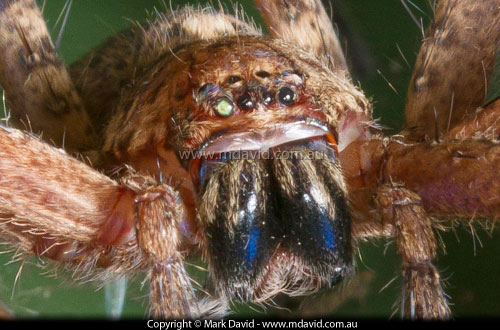
Whenever I see a Huntsman Spider I try to get a nice close look at its face. And I’ve been noticing some beautiful iridescence on these guys lately.
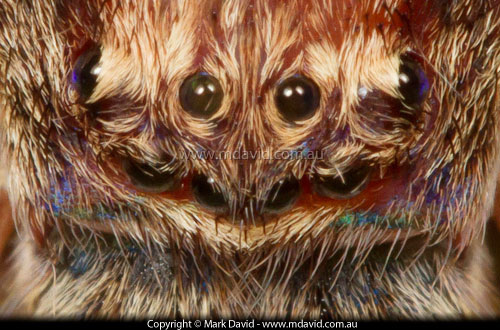
I’m talking about shimmering peacock blues, greens and pinks on what might otherwise be described as plain brown spiders.
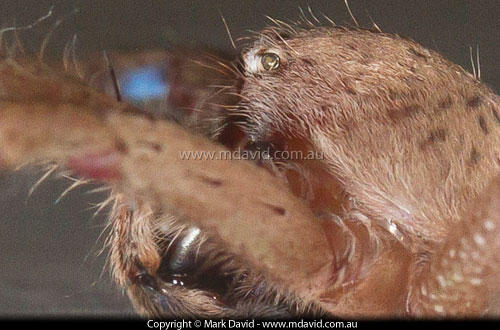
I’ve seen iridescence on a lot of spiders but it was a treat to find it on these Huntsmans too. What’s not to love about a spider with colours like these?
July 4, 2012
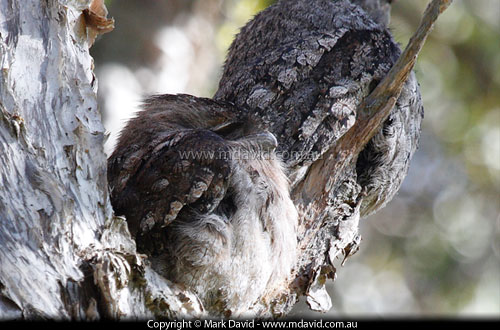
Here’s the kind of thing I mentioned in my last post. This looked like a couple of lumps on a branch. Most people can spot a frogmouth in this shot but of course there are two birds in this photo.
July 4, 2012
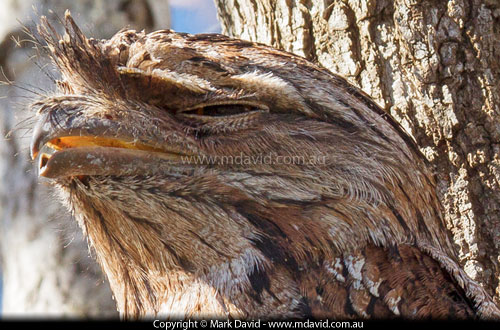
Here’s another pic of a Tawny Frogmouth. I’ll admit that I love these birds and think they are kind of fascinating too. Since taking an interest in wildlife photography I tend to be better at noticing stumps/lumps on branches that don’t look like branches. Which is how I’m finding Frogmouths.
June 25, 2012

Here’s a little bit of a close-up of the pic in the previous post. The dog’s in focus while everything else is not. I took a bunch of shots and about 90% of them were as sharp as this. There’s just no way I’d be able to adjust focus manually in a situation like this one. Despite its casual appearance, this little guy is moving very fast, coming straight towards me at about 30 or 40 kph.
June 25, 2012
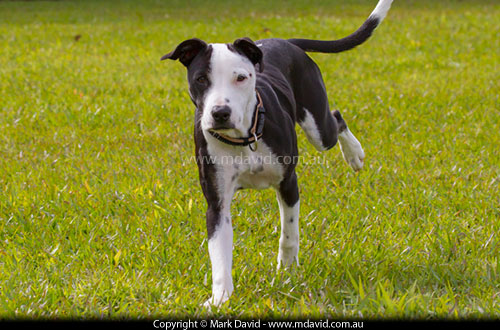
Dogs are great for practising wildlife photography.
Not only are they an easy size to focus on, but they actually come running when you call! I can only wish Fairy-wrens were that cooperative.
But how do you get tack-sharp photos of a pooch that’s running straight at you?
Modern SLR cameras make things so much easier than it used to be. I set my camera to shutter priority (at least 500th second but if the light’s strong I’ll go for 1,000th second), servo focus (so the focus keeps adjusting while the dog changes its distance from you), fast-burst shooting (because the action happens way too fast to time a single shot) and I also use my longest zoom (400mm) to get in close to the action.
By practising my camera technique on running dogs I was able to drastically improve my rate of keepers with pics of flying birds.
June 21, 2012
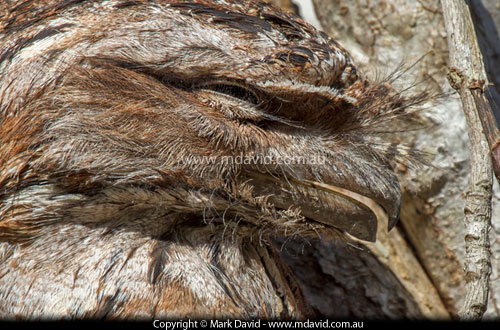
There’s an old expression often used — unfairly perhaps — about some wildlife: having a face only a mother could love. With Tawny Frogmouths, it’s more like ‘having a face only a mother could find.’
You see, these birds are so good at camouflage that you could easily walk right past one without seeing it. In this case, there were four frogmouths perched about ten feet above a busy footpath near a busy shopping centre and no one seemed to see them until I stopped to take their photos. Even when people did stop, one guy said, “That’s a lovely tree for a photo.” I still had to point out to him the bird that I was focusing on. And it was only about 6 feet away in clear view.
People often call these guys frogmouth owls, but if you want to be totally accurate (and who doesn’t like being totally accurate?) they are not actually owls. One difference is that owls tend to have big, powerful legs with which they grasp prey. Whereas these frogmouths have small legs and feet. That is, if they can find them.
June 21, 2012

During a walk lately I saw this Striated Pardalote on a wire fence.
The thing about pardalotes is that they are small. Crazy small. And the thing about photographing small birds is that it is crazy difficult. You see, small birds, especially crazy-small ones, rarely sit still. By the time you’ve managed to focus on where the bird is, it’s become an exercise in focusing on where the bird was.
So this was my only sharp shot out of about half a dozen attempts as it hopped along the wire. In a perfect world I would have a time machine that froze moments like this so I could set up my tripod and get the world’s best shot of a Striated Pardalote.
By the way, once you learn this bird’s name (I’ll say it one last time: Striated Pardalote) then you can easily remember its scientific name: Pardalotus striatus. There you go — feel free to drop that gem of knowledge into your conversation next time you see one of these birds. You know you want to.
June 5, 2012

It’s amazing what’s possible without fancy equipment. This photo shows part of the Transit of Venus — yep, that black dot in the upper left is Venus passing in front of the Sun. To get this image I mounted a pair of binoculars onto a tripod and aimed them at the sun. Then focused the binoculars onto a sheet of cardboard. This photo is of the image projected onto the cardboard. At no time did I need to look through the binoculars, or else I guess I’d be typing this message to you in Braille. I kept the binoculars covered when I wasn’t taking photos, as a precaution against them getting hot.
April 30, 2012
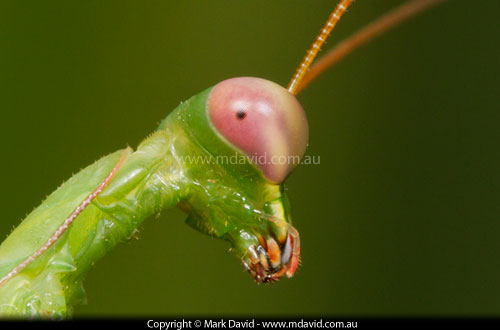
I’ve been reading about praying mantis eyes lately. But I guess everyone is, right? And the stuff I’m reading says that the reason the false pupil — that black dot in the huge compound eye — appears to follow your movement is to do with a trick in how light bounces off the surface of those eyes. It says that means the false eye will always be facing you. Well that sounds logical. But it doesn’t explain why the false pupil will sometimes also pulse on and off. Watching the eye in high magnification in real time made me suspect there is more to the story.
April 27, 2012
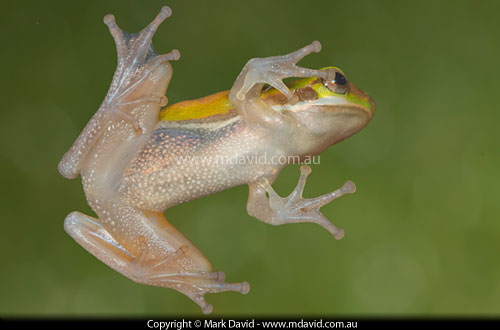
Hey, it must be hours since I last uploaded a frog photo. So here’s another one. Because most photos taken of frogs are looking down at them I think it’s kind of nice to sometimes see them from another angle. I took this photo some time ago but it gave me a great opportunity for a shot when it was climbing up the glass on one of our windows.
April 22, 2012
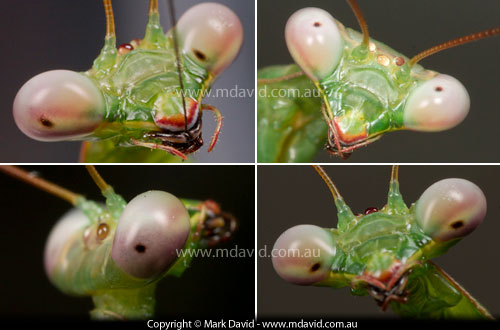
Insects can be sneaky sometimes. I’m talking about eyes that behave like TV sets!
Those big bulging eyes on either side of this praying mantis head are compound eyes. Which means they are made up of hundreds of individual lenses. So those big dots that look like pupils — well they are not really pupils but just a pattern of dots making some of those individual lenses look darker than the others. In other words, it’s not a pupil like we have in our eyes, but a fake pupil — a ‘pretend’ pupil.
But this praying mantis can make those dots move.
Just like a TV screen which is made up of screen pixels that change colour to make moving pictures, the lenses on this praying mantis eye can change colour, which makes the fake pupil move around to follow your movements. They also pulse on and off! Next time you see a praying mantis, have a look at those dots. They are kind of creepy but actually nothing more sinister than watching a television.
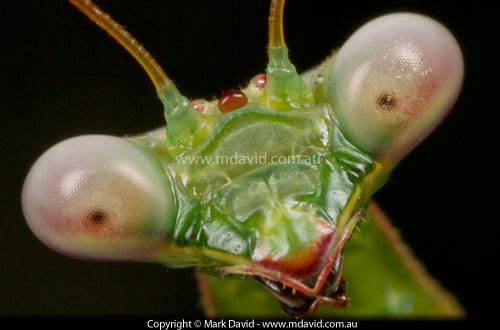
Here’s a closer look at that praying mantis (above), showing off its eyes better. You can see the individual lenses more clearly now.
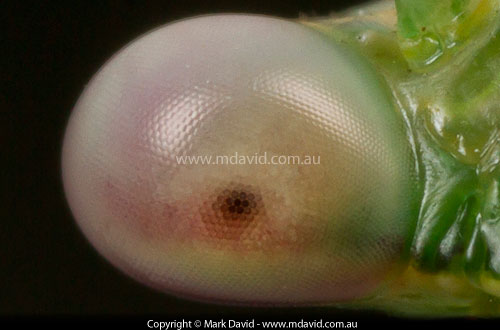
… And moving in a whole lot closer again (above), showing the fake/false pupil.
April 20, 2012
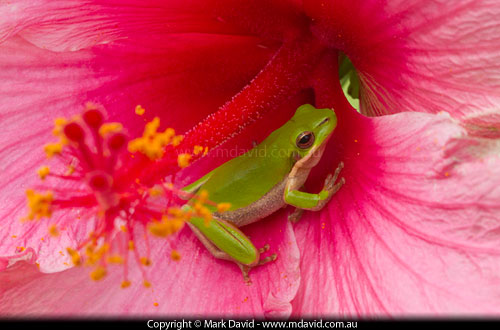
… And another pic like the previous post.
April 19, 2012
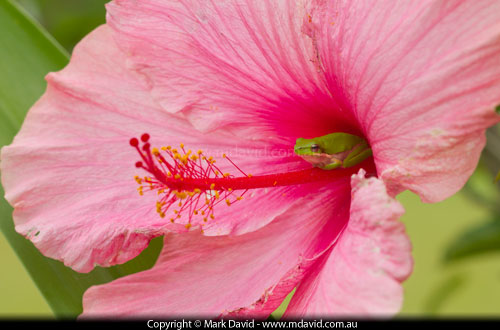
I know I’ve been running quite a few frog pictures, but with scenes like this happening outside it’s hard NOT to point a camera at these guys. So here’s some tropical colour — an Eastern Dwarf Tree Frog trying not to be seen in a Hibiscus flower. Camera settings were 80th second, f/11, tripod and no flash.
April 18, 2012
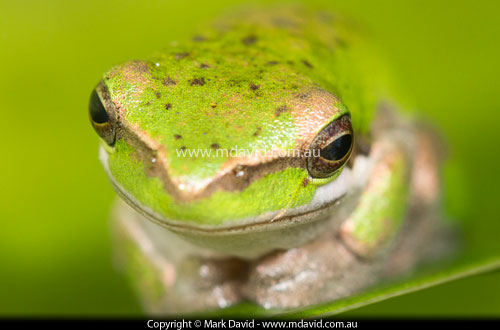
When I’m doing macro photography I often go to great lengths to get lots of depth of field. Otherwise most of your subject will be out of focus. But in this shot I went the opposite way, opening up the lens to f/7.1 — just enough to get the eyes in focus but not much more.
April 17, 2012
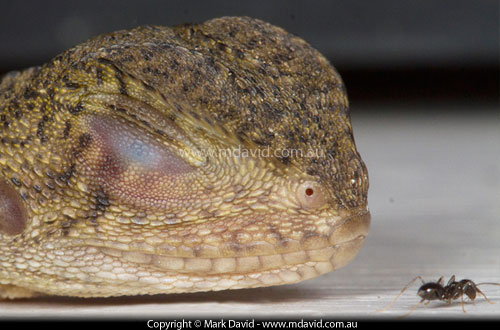
It can be frustrating if you’re taking a portrait shot and your subject blinks.
But if it’s a water dragon it can be kind of interesting. This little dude shows off its eyelid in this picture. I thought it was as cute as it was scaly. Of course the most difficult thing about getting a shot like this is in trying not to scare away your subject, because I had to get really, really close.
March 20, 2012
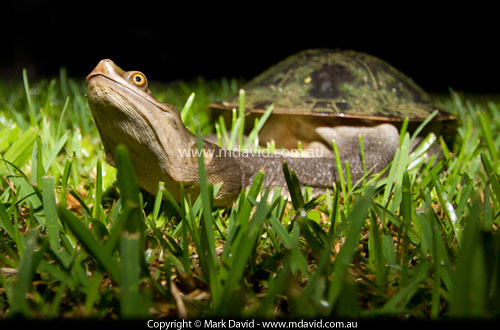
Going wide: a real lot of wildlife photos are taken with telephoto lenses, to bring the subject up nice and close. But sometimes it can be fun to do the complete opposite.
In this case I went as wide as my wide-angle zoom can go (10mm on a 1.6 cropped sensor, for you techies). And then bring the lens in as close as you can to the animal. I was only inches away from this freshwater turtle, but the wide-angle rewards you with a much more engaging view than telephoto. That’s because it not only sees the turtle, but it also takes in a sweeping view of the surrounding environment too, with a perspective that is much more suggestive of actually being there!
The result is a critter that has been ‘embedded’ into its scene like no telephoto can manage. But I stress that you need to get your camera up really, really close to the critter for this to work. Otherwise you’ll end up with a tiny, distant-looking distorted critter in a boring photo.